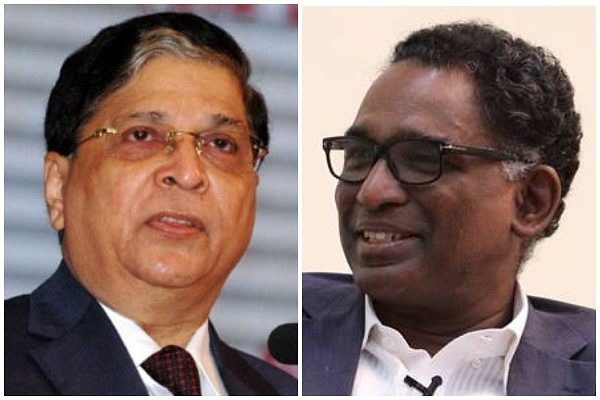
CJI Vs Rebels: Top Court Schism Can’t Be Fixed Without Revisiting NJAC Judgment
To fix the judiciary, including the executive-judiciary clash over powers, we need to revisit the NJAC again.
It is time to seek a new bench to review the five-judge bench’s order on the NJAC. Or draft another law to replace the NJAC based on consultations with the full Supreme Court.
The judgment of a three-judge bench headed by Chief Justice Dipak Misra, which effectively makes the Chief Justice of India (CJI) the final arbiter in the allotment of cases to various benches, is a correct one. This is despite the fact that the case arose largely because the CJI had reassigned a case taken up by Justice J Chelameswar to another bench, leading to an open revolt by the four senior-most judges in the top court last January, including Justice Chelameswar himself.
The bench, which included Justice A M Khanwilkar and Justice D Y Chandrachud, emphasised that the CJI was “first among equals”, with the “exclusive prerogative” on the allotment of cases. It also emphasised that “there cannot be a presumption of mistrust” about the discharge of the CJI’s constitutional responsibilities. It was this kind of mistrust that brought the four rebel judges out of their chambers and directly into public view.
The final judgment on the CJI’s supremacy, written by Justice Chandrachud, who himself will become CJI some time towards the end of 2022 if the current order of seniority and retirement is followed, has been criticised by some former judges and even some senior counsel (Shanti Bhushan). Bhushan and his son Prashant used the forum of Justice Chelameswar’s court today (12 April) to try and seek changes in how cases are allotted in another petition. To his credit, the judge refused to play ball, and said the matter should be heard by the CJI’s court.
The criticism against the three-judge bench’s order, that the CJI has primacy in deciding which cases should be decided by which bench, is that the CJI should not have heard a case in which he himself was interested. Former Delhi High Court Chief Justice A P Shah is quoted by The Indian Express as saying: “he (CJI Dipak Misra) should have not heard the matter. He should not have even constituted the bench. The issue involved is about the powers of the CJI. I am sure the CJI was aware about the other petition (Shanti Bhushan’s petition that a collegium of five senior judges should exercise the power to allocate cases, and not only the CJI). Why was the other petition not taken up with this? The system should be transparent, fair and just.”
This criticism can boomerang for two reasons.
If those who may be interested parties on some issue, directly or indirectly, cannot hear the cases, it follows that no collegium judge should hear Shanti Bhushan’s case either, since they too can be said to be interested parties in how cases are allocated. They are the ones seeking to curtail the CJI’s powers and enhance theirs.
The second point is more fundamental. One cannot, beyond a point, say that interested parties in the judiciary should not be adjudicating cases in which they may have some interest, since this is the role the constitution gives the judiciary (to interpret all aspects involving the law, including laws that may impact the judiciary). If this was not the case, why did the special five-judge constitution bench hear the case on the National Judicial Appointments Commission (NJAC), when it was an interested party in seeking to retain the collegium system of appointing judges to the higher judiciary?
If we accept that the Supreme Court can adjudicate matters in which it is an interested party, even if only in an institutional sense of the term, it follows that a CJI-led bench can hear cases in which the office of the CJI may be interested. It is not just about CJI Dipak Misra and his powers. It is about the office of CJI.
If we take a step back, the original sin was the judiciary’s decision to chuck out the NJAC lock, stock and barrel instead of merely reading it down to preserve judicial independence. The frost in executive-judiciary ties, and the confrontation inside the judiciary itself, can be traced to the fact that the judiciary has sought to keep all power with itself: the power to appoint judges, the power to punish them, and the power to tell every other branch of the state what to do.
The balance of power has been disturbed by the judiciary in the NJAC case. The solution to restoring the balance is to take the job of judicial appointments partly away from the collegium, by creating a permanent body to sift and sort shortlists of judges who can be promoted to the higher judiciary (with the collegium taking its final pick from the short-list, with additional advice from the executive), and to additionally create a judicial accountability bill to investigate and take action against errant judges. Right now, the only way to get rid of a rotten judge is through the process of impeachment, which is the right instrument for various kinds of judicial transgressions. This is a point even Justice Chelameswar agrees with.
To fix the judiciary, including the executive-judiciary clash over powers, we need to revisit the NJAC again. It is time to seek a new bench to review the five-judge bench’s order on the NJAC. Or draft another law to replace the NJAC based on consultations with the full Supreme Court.